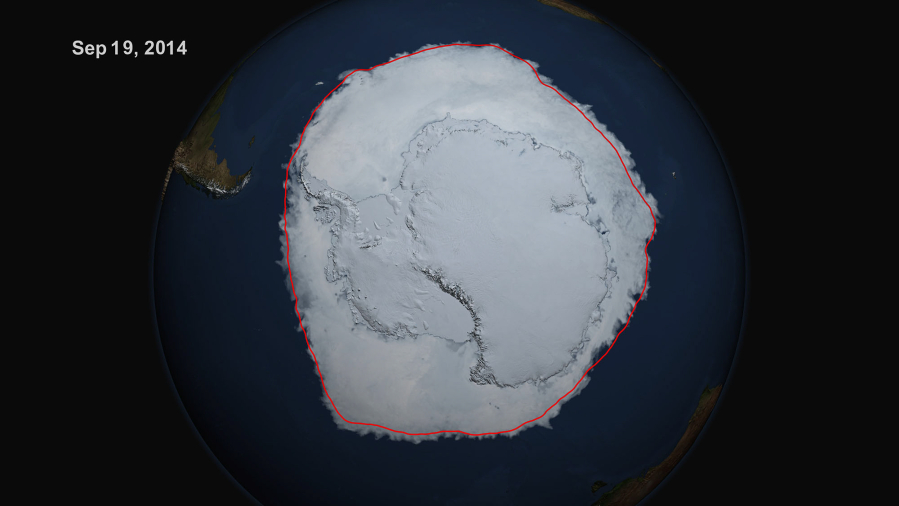For a number of years now, climate change skeptics and doubters have argued that there’s a key part of the Earth’s climate system that upends our expectations about global warming, and that is showing trends that actually cut in the opposite direction.
This supposed contrary indicator is the sea ice that rings the Antarctic continent, and that reached a new all-time record extent of 7.78 million square miles in September of 2014. As that record suggests, this vast field of ice has clearly been expanding in recent years, rather than shrinking. That means it’s doing the opposite of what is happening in the Arctic, where sea ice is declining rapidly — and also that it’s doing the opposite of what we might expect in a warming world.
Scientists don’t fully understand why Antarctic sea ice is growing. Suggested explanations have posited more glacial melt dumping cold fresh water into the surrounding seas, or the way the Antarctic ozone hole has changed the circulation of winds around the continent. In a new study in Nature Geoscience, though, researchers with the National Center for Atmospheric Research (NCAR) in Boulder, Colo., along with colleagues from the University of Washington in Seattle and Australia, suggest that the phenomenon is simply the result of natural variability of the climate system — driven, in this case, by changes in the tropical Pacific Ocean that reverberate globally.
“When you get changes in (sea surface temperatures) in some areas of the tropics, you affect precipitation, that affects the amount of energy released in the atmosphere,” said Gerald Meehl, the study’s lead author and a climate scientist with NCAR. “That starts affecting, through this kind of chain reaction process, circulation at great distances away.”
The new study confirms that the ice floating around Antarctica has been expanding — indeed, the expansion has accelerated since around the turn of the century. But that’s also around the time that a cycle dubbed the “Interdecadal Pacific Oscillation,” or IPO, shifted into a negative phase, which is characterized by ocean surface cooling in the tropical Pacific, and particularly its eastern part around the equator.
This is the same phenomenon that, scientists like Meehl believe, helped fuel a so-called global warming “slowdown” or “hiatus” during the 2000s. Heat was in effect buried deep below the surface of the Pacific Ocean, rather than bursting forth and influencing the globe, during this period.
But what’s new in the latest study is the suggestion that this negative IPO phase had consequences that stretched all the way to the Southern Ocean waters surrounding Antarctica — and that this, in turn, explains why most climate models failed to predict the observed growth of Antarctic sea ice.
Most of the state-of-the-art climate change model simulations run to help support the 2013 report of the United Nations’ Intergovernmental Panel on Climate Change did not capture the growth of Antarctic sea ice that has occurred of late. Rather, the average of these models suggested this ice should decline. This shows that skeptics who have cited the growing ice are raising a serious concern — this anomaly really does cry out for an explanation.
But the new study finds that in the small minority of climate change simulations that do happen to correctly capture these natural changes in the Pacific, and the global warming “slowdown” to boot, there is also growth in Antarctic sea ice. These are the models, it appears, that happened to get the role of natural variability in the Pacific right — or more specifically, to get the timing right for a phase shift in this ocean.
Out of “262 realizations of 20th-century climate, 10 of those got this observed slowdown of global warming happening at about the same time as in the observations, at the same magnitude,” said Meehl. “And for those 10, there was the negative phase of the IPO, and it also has the signature of Antarctic sea ice.”
But how could a naturally occurring climate wobble in the tropical Pacific Ocean translate into more Antarctic sea ice?
The research suggests the key factor is how the state of that ocean in turn influences an Antarctic atmospheric phenomenon called the Amundsen Sea Low, a low-pressure region off the Antarctic coast that lies more or less directly south of the tropical Pacific.
This low-pressure region deepens (or, sees its pressure drop even further) in negative IPO conditions, the study finds, which drive cooler seas in the eastern tropical Pacific. As this shift reverberates across the globe, it in turn means that down in Antarctica, winds increase in force around the area of low pressure at the center of the Amundsen Sea Low (winds blow inward toward regions of lower pressure). These stronger winds, in turn, push sea ice outward and away from the Antarctic continent, which leaves room for more ice to form in the gaps that are created — and increases the extent of sea ice overall.
“The dramatic decrease in Arctic sea ice, which currently exceeds model predictions and could exhibit a record or near-record low this year, is fairly straightforward to understand in terms of the unprecedented warming in the Arctic,” said Michael Mann, a climate research at Penn State University, in an email in response to Meehl’s study.



